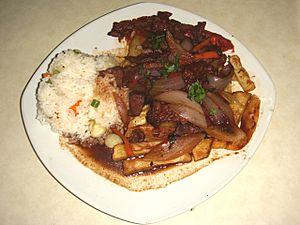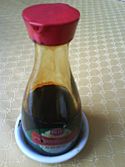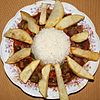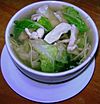Chifa facts for kids

Chifa is culinary tradition based on Chinese Cantonese elements fused with traditional Peruvian ingredients and traditions. Though originating in Peru, the Chifa tradition has spread to neighboring countries like Ecuador, Chile and Bolivia. Chinese immigrants came to Peru mainly from the southern province of Guangdong and particularly its capital city Guangzhou in the late 19th and early 20th centuries. They settled for the most part in the coast of Peru and the capital city of Lima. The term chifa is also used to describe a restaurant where this type of food is served. Chinese-Peruvian food has become one of the most popular types of food in Peru. The first Chinese–Peruvian fusion restaurants were opened in Lima in around 1920 in Lima's China town (Barrio Chino); there are thousands of Chifa restaurants across all districts of Lima and many more throughout other cities of Peru, with sometimes multiple independent restaurants operating in close proximity on a single city block.
Etymology
The Chinese Peruvians are from southern China, particularly Canton. The Comisión Lexicografía de la Academia Peruana (CLAP) proposed that it is from Cantonese 食飯喇 sik9 fan6 la3 "let's eat". A similar loanword, chaufa (a fried rice dish), comes from the Cantonese 炒飯 (Jyutping: caau3 faan6) or "fried rice."
History
As Chinese immigrants in Peru progressed economically, they imported a limited number of ingredients to be able to produce a more authentic version of their home cuisine. Additionally, they began to plant a variety of Chinese vegetables with seeds imported from China. However, due to a lack of ingredients, the Chinese were not able to prepare their cuisine in the authentic manner of their homeland.
Around 1920, the first Chinese Peruvian restaurants were opened in Lima and were given the name Chifa. The Limeña aristocracy was amazed by the bittersweet sauce, chaufa rice, the soup, and other dishes of the ancient cuisine. Wealthy Limeños became fascinated by Chifa, to an extent that in some regions of the country there are more chifas than creole (which here is used to refer to the natives) restaurants.
Peruvian chefs began to use products used in traditional Chinese cooking such as ginger, soy sauce, scallions, and a variety of other ingredients which began to make their way into daily Limeña cuisine.
There are different accounts on the development of chifa restaurants in Lima, the Peruvian capital, such as the following:
"Why is the Chinatown of Lima near the central market called Capon? Because on Ucayali Street pigs, bulls, sheep and goats were fattened to be made more appetizing. Near Capon Street there was a piece of land known as Otaiza, which was rented by a group of Chinese free of the [indenturement] contract, doing what they best knew how to do: cooking and merchanting (...) Capon turned into the birthplace of Chinese food and of the first Peruvian chifas, a blessing from the sky. Soon all of Lima comes to eat at Ton Kin Sen, to Thon Po, to Men Yut, and to San Joy Lao where there was dancing to a live orchestra. Chinese restaurants became known as Chifa. For some this word was derived from the Chinese ni chi fan or "Have you eaten yet". Soon later would come the dish chau fan (fried rice), and finally, chaufa, a dish that comes with almost every chifa meal."
- León, R., 2007 pp.134-136.color
The history of chifa is deeply rooted in the development of the Chinatown of Lima, which has become focal point in cultural, artistic, commercial, and especially gastronomic interest. Chinatown is located near Capon Street in Barrios Altos, in the Historic Centre of Lima.
Cuisine

Peruvian chifa is distinct, due to its Peruvian cuisine influences. Like most Chinese food internationally and within China, rice, meat, noodles and vegetables are important staples to chifa. Chifa is enjoyed by all socioeconomic levels, evidenced by chifas directed toward those with more disposable income, while chifas de barrio are directed towards a different social strata. Currently, in the city of Lima there are over 6,000 chifa restaurants.
Chifa dishes
| Name | Image | Description |
|---|---|---|
| Arroz chaufa | Cantonese-Peruvian style Fried Rice (white rice, soy sauce, scallions, fried egg, and meat such as chicken or pork) | |
| Tallarin Saltado |  |
Cantonese-Peruvian style Chow Mein |
| Lomo Saltado |  |
Stir-fried marinated sirloin strips with onions, tomatoes and peppers and served with french fries and rice. |
| Pollo Chi jau kai | Chicken with Chu-Hou sauce | |
| Pollo Tipa Kay |  |
Chicken with Sweet and Sour sauce. |
| Pollo enrollado |  |
Chicken rolled into fried crust |
| Chicharron de pollo | Fried simmered chicken cubes served with spiced lemon juice | |
| Pollo con tausi | Seasoned chicken with a dark broth | |
| Aeropuerto | A mixture of Arroz chaufa and Tallarin saltado | |
| Wantan frito |  |
Fried wonton |
| Sopa Wantan |  |
Cantonese-Peruvian style Wonton soup |
| Kam Lu Wantan |  |
Wontons stir fried with Sweet and sour sauce, vegetables and meat |
| Sopa estilo chifa | Chinese-style chicken soup | |
| Sopa Fu chi fu | Egg drop soup | |
| Taypa a la plancha |  |
Stir fry of beef, pork, chicken, fried tofu puffs, seafood, vegetables |
Chifas in other countries
Since at least the 1970s, Chinese immigrants had also opened chifas in neighboring Ecuador. Chifas have also been opened in Bolivia and Chile.
See also
 In Spanish: Gastronomía chifa para niños
In Spanish: Gastronomía chifa para niños


